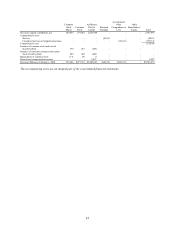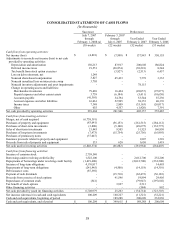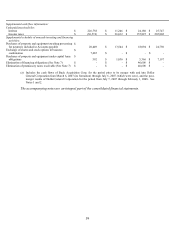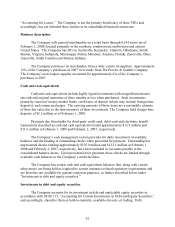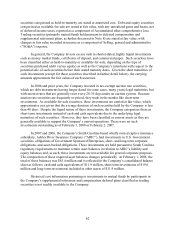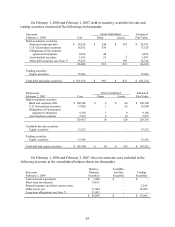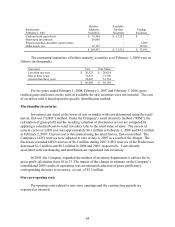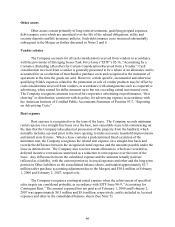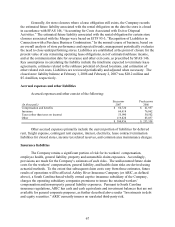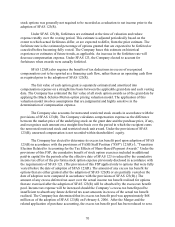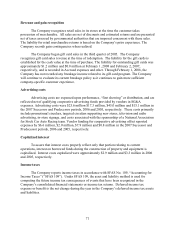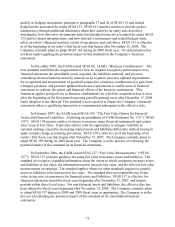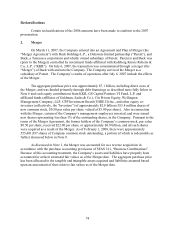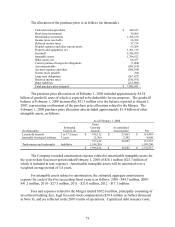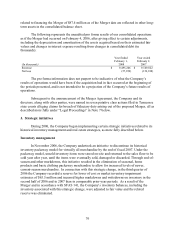Dollar General 2007 Annual Report Download - page 68
Download and view the complete annual report
Please find page 68 of the 2007 Dollar General annual report below. You can navigate through the pages in the report by either clicking on the pages listed below, or by using the keyword search tool below to find specific information within the annual report.66
Other assets
Other assets consist primarily of long-term investments, qualifying prepaid expenses,
debt issuance costs which are amortized over the life of the related obligations, utility and
security deposits and life insurance policies. Such debt issuance costs increased substantially
subsequent to the Merger as further discussed in Notes 2 and 6.
Vendor rebates
The Company accounts for all cash consideration received from vendors in accordance
with the provisions of Emerging Issues Task Force Issue (“EITF”) 02-16, “Accounting by a
Customer (Including a Reseller) for Certain Consideration Received from a Vendor.” Cash
consideration received from a vendor is generally presumed to be a rebate or an allowance and is
accounted for as a reduction of merchandise purchase costs and recognized in the statement of
operations at the time the goods are sold. However, certain specific, incremental and otherwise
qualifying SG&A expenses related to the promotion or sale of vendor products may be offset by
cash consideration received from vendors, in accordance with arrangements such as cooperative
advertising, when earned for dollar amounts up to but not exceeding actual incremental costs.
The Company recognizes amounts received for cooperative advertising on performance, “first
showing” or distribution, consistent with its policy for advertising expense in accordance with
the American Institute of Certified Public Accountants Statement of Position 93-7, “Reporting
on Advertising Costs.”
Rent expense
Rent expense is recognized over the term of the lease. The Company records minimum
rental expense on a straight-line basis over the base, non-cancelable lease term commencing on
the date that the Company takes physical possession of the property from the landlord, which
normally includes a period prior to the store opening to make necessary leasehold improvements
and install store fixtures. When a lease contains a predetermined fixed escalation of the
minimum rent, the Company recognizes the related rent expense on a straight-line basis and
records the difference between the recognized rental expense and the amounts payable under the
lease as deferred rent. The Company also receives tenant allowances, which are recorded as
deferred incentive rent and are amortized as a reduction to rent expense over the term of the
lease. Any difference between the calculated expense and the amounts actually paid are
reflected as a liability, with the current portion in Accrued expenses and other and the long-term
portion in Other liabilities in the consolidated balance sheets, and totaled approximately $3.7
million (after purchase accounting adjustment due to the Merger) and $30.4 million at February
1, 2008 and February 2, 2007, respectively.
The Company recognizes contingent rental expense when the achievement of specified
sales targets are considered probable, in accordance with EITF Issue 98-9, “Accounting for
Contingent Rent.” The amount expensed but not paid as of February 1, 2008 and February 2,
2007 was approximately $8.3 million and $8.6 million, respectively, and is included in Accrued
expenses and other in the consolidated balance sheets (See Note 7).



